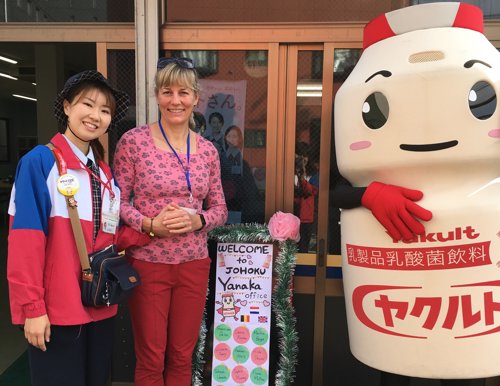
News
Healthy ageing and probiotics in Japan
Written by Carrie Ruxton PhD, RD Freelance dietitian and health writer
As a huge fan of Japanese food and someone who has always been curious about the culture, I was delighted to be offered a place on the Yakult press trip to Tokyo. It was a week of contrasts from my home in Scotland – in terms of food, people, culture and public health issues.
The theme of the trip was healthy ageing, which is highly relevant as Japan faces the duel challenges of a declining birth rate and an ageing population. By 2020, it’s been estimated that half of Japanese women will be over 50 years and by 2060, nearly four in ten Japanese adults will be in the 65+ years category. The rise in numbers of elderly, many of whom will develop dementia and other chronic illnesses, places pressure on health funding, care structures and taxpayers, as it requires two working adults to support the care costs of one elderly person. Japan is, understandably, very interested in how to maintain health and independence in its elderly population through diet, activity and improved gut health.

Biotopia
Our packed educational programme included lectures from academics and Yakult staff, and visits to a cutting-edge care home, a community centre, the Yakult Institute, a huge supermarket, and a rural lifestyle centre called Biotopia.
Biotopia is an amazing concept – a 60 hectare area of land in the Kanagawa prefecture under the imposing gaze of Mount Fuji devoted to health and wellbeing. Funded by a private company in partnership with local government, Biotopia offers the public an opportunity to check their fitness using fun interactive computer tests (free), eat healthy food in the restaurant, buy local and organic foods and beauty products and enjoy roaming the extensive forest paths.
Gut health
Given the expertise of our hosts, it was no surprise that gut health featured as a topic. We learnt from our speaker, Professor Eric Classen, that approximately 100 trillion bacteria live on, or in, our bodies, meaning that we harbour more bacteria than cells!
Bacteria exist mostly in the colon but are also present across the whole gut. Helicobacter, for instance, survives in the harsh low pH environment of the stomach but only because it resides within the crypts (folds) which provide some protection from stomach acid.
Despite there being no authorised health claims in Europe, there are thousands of international peer-reviewed papers about probiotics.
Probiotics, which can withstand the pH extremes of the upper GI tract and reach the colon intact, are thought to have positive effects due to competition with potentially pathogenic bacteria species, and the secretion of short-chain fatty acids. Lactobacilli and bifidobacteria, the most common probiotic genera, secrete lactic acid which creates a low pH environment that cannot be tolerated by pathogenic species. In addition, their presence in large numbers reduces the availability of adhesion sites for pathogens to colonise.
The secretion of short-chain fatty acids, such as propionate and butyrate, also supports health as these fermentation by-products can cross the epithelial barrier and modulate immune function, inflammation, apoptosis (natural cell death) and liver enzymes – processes which influence risk of chronic disease development.
Variety of probiotic products
I was surprised by the array of Yakult products in Japan, being used to seeing only the regular and lower-sugar probiotic shots. As well as these, which officially contain 6.5 billion bacteria, Yakult produce higher dose versions with either 40 billion bacteria or 100 billion bacteria, powders and synbiotics (with galacto-oligosaccharides). On top of this, there are probiotic cosmetics, such as face creams, and regulated anti-cancer drugs. The extent of the probiotic and prebiotic markets in Japan reminds us that functional foods there have been around a lot longer compared with Europe.
Culture
Everything in Japan is different from Scotland, except the friendliness of the people. Respect for the elderly is widespread and Japan even has a Respect for the Aged day where older neighbours and family members are presented with a flower and greeting card. The care home that we visited had a refreshing atmosphere with private rooms, bright communal areas, a lovely garden and plenty of activities.
I found the food most enjoyable – from the Bento boxes to the raw tuna, white fish and octopus. I tried seaweed, pickles, egg dishes and unidentifiable vegetables. Luckily, I had some pre-existing knowledge of Japanese food as, at the official Yakult dinner, one of the senior executives attempted to convince me, unsuccessfully, that the dish of wasabi was green tea ice-cream! We all laughed at the joke – proving that humour transcends language barriers.
As I returned to the UK and looked over my photographs which included tiny ladies in elegant kimono, the crazy 6-way Shibuya road crossing, the perfectly groomed parks, majestic Mount Fuji and the impressive city scape of Tokyo, I knew I would return again very soon.
Acknowledgment and conflict of interest
I express my sincere thanks to Yakult for inviting me and covering all expenses relating to my trip. I received no fee for participating in the press trip. The opinions expressed here are mine alone and do not represent those of any organisation with which I am affiliated.
19/02/2020